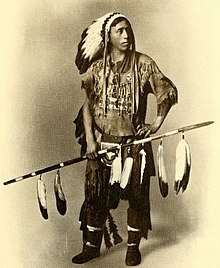Grace Chandler
Grace Chandler (1879 – February 12, 1967), also known as Grace Chandler Horn, was an American photographer based in Michigan, best known for her photographs of Native American subjects.
Early life
Grace Maude Chandler was born in Barry County, Michigan, the daughter of David Martin Chandler and Jane Amanda Delphine Chandler. She had sisters Effie Mabel Chandler (Woodworth) and Ila Blanch Chandler (Jones), and a brother Charles Chandler.[1]
Career

Chandler started her work in photographer as an assistant to her brother, Charlie Chandler, at his photography studio. As Grace Chandler Horn, she operated the Horn Art Shop in Petoskey, Michigan with her husband from 1899 to 1913, and then on her own. Her shop was part of the tourist attractions built around the annual "Hiawatha Pageant" in Petoskey,[2] so its best sellers were prints and postcards related to that event.[3][4] Her photographs of the Ojibwe performers and scenes in the pageant were published in 1911 as illustrations in an edition of Longfellow's The Song of Hiawatha.[5] A second volume featuring her work appeared the next year, as an illustrated libretto of the pageant, published by the railroad.[6][7]
In 1917 her Native American and nature photographs were exhibited by the Arts Association of Grand Rapids, Michigan.[8] In 1923 she moved to Los Angeles, California and opened the Grace Chandler Studio. Her photographs included California landscapes, animal studies, and portraits. She did her own hand-coloring on some images.[6]
Personal life
Grace Chandler married by 1899; that marriage ended in divorce in 1913. She married again in 1917, to James Homer Depeau, but Depeau (or DePew) proved to be legally married to another woman.[9] In 1928, Grace Chandler Horn's sister was concerned about her mental health, based on letters about her interest in mysticism. Grace Chandler was committed as a patient to Norwalk State Hospital. She was institutionalized for nearly forty years. She died in 1967, aged 87 years.[6]
Legacy
Grace Chandler Horn left about four hundred photographs from her active years (1899 to 1928), many of them in private collections, but over 200 of them in the Peter Palmquist Collection of Women in Photography at Yale University Library.[10] In 2003 a small show of landscapes by Grace Chandler was presented at the Kresge Art Museum at Michigan State University, with her Native American-themed works on display at the same time, at the Nokomis Learning Center in Okemos, Michigan.[6]
References
- "Hold Last Rites of Mrs. Woodworth" The News-Palladium (December 15, 1939): 14. via Newspapers.com

- Alan Trachtenberg, Shades of Hiawatha: Staging Indians, Making Americans, 1880-1930 (Macmillan 2005): 92. ISBN 9780809016396
- Bill Castanier, "History on Film: Photography talk explores early Native American photography" Lansing City Pulse (December 9, 2015).
- Michael D. McNally, "The Indian Passion Play: Contesting the Real Indian in 'Song of Hiawatha' Pageants, 1901-1965" American Quarterly 58(1)(March 2006): 105-136.
- "Rand McNally & Company" The Bookseller, Newsdealer and Stationer" (November 15, 1911): 474.
- "Grace Chandler: Landscape Photographs, 1908-1923" Kresge Art Museum, Michigan State University.
- Libretto: Indian play -- Hiawatha, played at Wa-ya-ga-mug, on the Grand Rapids and Indiana Railway, near Petoskey, Michigan, each summer season, by native Ojibway Indians; illustrations from original photographs by Grace Chandler Horn (General Passenger Department, Grand Rapids and Indiana Railway 1912).
- "Grand Rapids (Mich.)" American Art News (March 17, 1917): 6.
- "Petoskey" Lansing State Journal (May 10, 1917): 7. via Newspapers.com

- Guide to the Peter Palmquist Collection of Women in Photography, Yale University Library.
External links
- A 1915 letter from Grace Chandler Horn to the Carlisle Indian School about a possible exhibition of photographs, in the Ella Petoskey Student File, Carlisle Indian School Digital Resource Center.
- Postcard photograph by Grace Chandler Horn, "Departure of the Warriors" (1910), in the National Museum of the American Indian, and in the Smithsonian Online Virtual Archives.